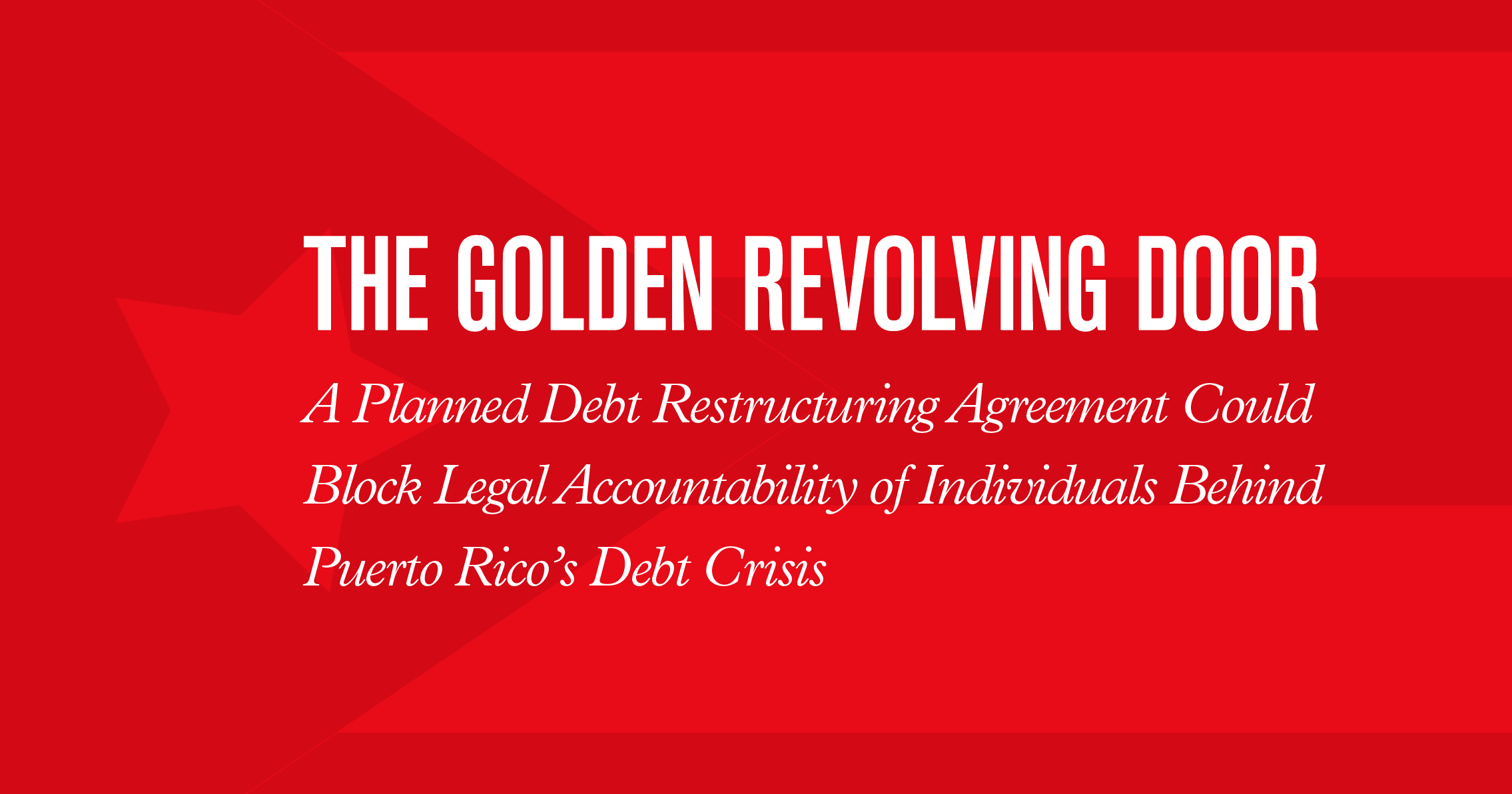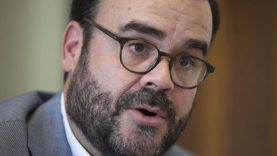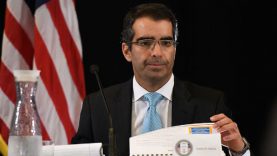
Download as PDF or read below
HedgePapers No. 61: THE GOLDEN REVOLVING DOOR: How A Planned Debt Restructuring Agreement Benefits The Bankers — and Could Block Puerto Rico From Holding Them Legally Accountable
Spanish version of the report. Executive Summary An agreement nearing approval as part of Puerto Rico’s debt restructuring process could block many forms of legal accountability for a key set of government officials and bankers that oversaw the creation of the debt – and stick credit unions and municipalities with the tab. The restructuring agreement for $4 billion in Government Development Bank (GDB) debt was negotiated quietly and behind closed doors, as part of PROMESA’s out-of-court Title VI process, by conflicted players – revolving door figures who were previously officials at the GDB, have played some oversight role with respect to the debt, and/or have close ties to financial institutions that have profited from debt issuances over the years. The agreement is now in the voting stage, and will need to secure votes in favor from two-thirds of GDB creditors. Once the agreement is final, little-noticed provisions in the agreement itself and in the GDB Restructuring Act of 2017 will take effect that will block significant forms of legal action against these officials and related institutions. In other words, people who oversaw and profited from the creation of Puerto Rico’s massive debt have negotiated releases from legal accountability for themselves and their associates. One of these revolving door bankers was Gerardo Portela, Governor Ricardo Rosselló’s lead representative in negotiating the agreement. Until July, Portela was executive director of Puerto Rico’s fiscal agency (AAFAF) and was formerly an executive with oversight of public finance deals at Santander, a bank which profited heavily from the creation of the debt. Rosselló removed Portela from his position in July, creating the appearance of distance between this conflicted network and the final deal. Puerto Rico’s credit unions and municipalities are key parties to the agreement, and many will need to vote in favor for it to go through. The restructuring could result in significant financial damage to both:- Credit unions invested in Puerto Rico’s debt early on and have suffered significant financial harm as a result of the debt crisis. As a result of the releases in the agreement, these credit unions will give up their ability to secure valuable financial damages that could outstrip their recoveries. The solicitation statement for the agreement warns bondholders of this risk.
- Municipalities will face major financial consequences if the agreement goes through. They will be required to provide the majority of the payment stream that the refinanced bonds will depend on: payments on GDB loans, which are largely sourced from property and sales taxes. These loans have not been written down substantially, unlike the GDB bonds. As they face growing deficits, hurricane recovery costs, and funding cuts, municipalities will likely struggle to meet these obligations, and tax hikes, more aggressive collections, layoffs, privatizations, and support from the Commonwealth could result.
- Once the restructuring deal closes, the GDB and GDB officials, as well as other “agents or representatives” of the GDB – which could include banks, law firms, and other outside parties – will be shielded from civil legal action brought by Puerto Rico government authorities. This is due to a little-noticed article in the GDB Debt Restructuring Act of 2017. The law could be interpreted to apply not only to GDB-issued debt, but all GDB actions.
- The legal releases provided for in the agreement are broad, and block many forms of legal action with respect to not just the GDB and creditors, but also their current and former officers and directors – as well as attorneys, investment bankers, financial advisors, and a host of other associated individuals and entities. The solicitation statement acknowledges that these legal releases could block potentially valuable claims.
 Gerardo Portela: AAFAF’s recently demoted Executive Director worked for many years for Santander Securities, and was involved in $5 billion in public financing deals in Puerto Rico. As AAFAF executive director, he oversaw the GDB restructuring process for the government, and so is at least partially responsible for the broad releases from legal liability included in the agreement.
Gerardo Portela: AAFAF’s recently demoted Executive Director worked for many years for Santander Securities, and was involved in $5 billion in public financing deals in Puerto Rico. As AAFAF executive director, he oversaw the GDB restructuring process for the government, and so is at least partially responsible for the broad releases from legal liability included in the agreement.
 Jorge Irizarry: Irizarry is participating in the negotiations around the GDB restructuring as Executive Director of Bonistas del Patio, a nonprofit organization that is representing Puerto Rican bondholders. As GDB president in 2007-2008, he authorized three disastrous Employees Retirement System bond issues. Irizarry had family ties to an executive at UBS involved in the bond issues.
Jorge Irizarry: Irizarry is participating in the negotiations around the GDB restructuring as Executive Director of Bonistas del Patio, a nonprofit organization that is representing Puerto Rican bondholders. As GDB president in 2007-2008, he authorized three disastrous Employees Retirement System bond issues. Irizarry had family ties to an executive at UBS involved in the bond issues.
 Paul Hopgood: The two credit union coalitions that are parties to the deal are being advised by Hopgood, a former Santander executive.
Paul Hopgood: The two credit union coalitions that are parties to the deal are being advised by Hopgood, a former Santander executive.
 Additionally, the agreement requires approval from the federal oversight board to move forward, and several members of the board potentially gain newprotections from some forms of legal action as part of the deal, since they are former GDB officials and/or have close ties to financial institutions that wereheavily involved in creating the debt. The most prominent example of this is Carlos Garcia, who was a central figure in the revolving door between Santander and GDB and is now a member of the oversight board.
Additionally, the agreement requires approval from the federal oversight board to move forward, and several members of the board potentially gain newprotections from some forms of legal action as part of the deal, since they are former GDB officials and/or have close ties to financial institutions that wereheavily involved in creating the debt. The most prominent example of this is Carlos Garcia, who was a central figure in the revolving door between Santander and GDB and is now a member of the oversight board.
- The GDB restructuring blocks many forms of legal accountability for people who caused debt crisis
- The Ad Hoc Group of GDB Creditors, a group of hedge funds that have speculated on GDB debt, buying at low prices in the interest of receiving high payouts on the debt. This group includes Avenue Capital, Brigade Capital Management, Fir Tree Partners, and Solus Alternative Asset Management.[3]
- Bonistas del Patio, or Backyard Bondholders, a group which claims to represent many bondholders in Puerto Rico.
- Alianza de Cooperativistas, a coalition of credit unions with GDB bonds.
- Grupo Encuentro Solidario, another coalition of credit unions
- The Government Development Bank (GDB)
- Puerto Rico Fiscal Agency and Financial Advisory Authority (AAFAF)
- Bankers with significant conflicts of interest have played a central role in negotiating and overseeing the deal
- Carlos Garcia, an oversight board member and perhaps the most infamous example of Santander’s revolving door with the GDB. Garcia left his executive role at Santander to become president of the GDB from January 2009 to March 2011, during which time the GDB authorized the issuance of approximately $19.7 billion in public debt. This translated into a total of around $236 million in commissions paid for the underwriters, including Santander.[32] He also presided over the Fiscal Restructuring and Stabilization Board, a board created by Act 7, which managed the firing of thousands of public sector workers.His return to Santander coincided with the acceleration of the bank selling its investment funds that had a high level of exposure to bonds of the Puerto Rico government.[33] Even as Santander as an institutional investor stopped buying Puerto Rico’s bonds, it continued to encourage its clients to invest in government debt.[34] As an oversight board member, Carlos Garcia has the power to approve the GDB deal that will provide him and his associates with legal releases. Another oversight board member, Jose Ramon Gonzalez, is also a former Santander and GDB executive.
- Fernando and Juan Carlos Batlle. The Batlle brothers were also key players in Santander’s revolving door with the GDB. During Carlos Garcia’s presidency of the GDB, Fernando Batlle was his second in command, and Juan Carlos Batlle oversaw Santander Securities, which underwrote many of the bonds the GDB was authorizing.[35] Fernando was also Executive Director of COFINA, where he oversaw the biggest bond issue in the history of Puerto Rico, a $4.1 billion debt issue in June 2009.[36] When Carlos Garcia and Fernando Batlle resigned from the GDB in March 2011 and returned to Santander, Governor Fortuño named Juan Carlos as the new GDB President. While presiding over the GDB, Juan Carlos Batlle authorized six bond issuances totalling approximately $4.6 billion. He also authorized another four bond emissions from COFINA totalling approximately $1.9 billion. Santander acted as underwriter for the majority of these bonds.The Batlle brothers are now Senior Managing Directors of Ankura Consulting Group, a firm that provides management consulting and expert services to businesses, including on bankruptcy and restructuring.[37] Days after Juan Carlos joined Ankura in 2017, Ankura signed its first contract with the government of Puerto Rico, a contract with the GDB to work as its financial advisor.[38] That contract was for four months for a total of $1.6 million. Since then Ankura has signed another eight contracts, another with the GDB, three with PREPA, and four with AAFAF.[39]
 III. Credit unions and municipalities could suffer significant financial damages as a result of the deal – and are a final obstacle to approval
Credit unions, which hold GDB bonds, and municipalities, which have deposits at and loans from the GDB, are among the final obstacles to a deal going through. Many of them will need to join in approving the deal for it to become final. Both could also suffer significant financial harm when the restructuring becomes final.
Credit unions
Credit unions are part of a cooperative financial system comprised of around 115 credit unions. Taken as a whole they are the third largest financial institution in Puerto Rico.[40] They are supervised and regulated by COSSEC (Corporacion Publica para Supervision y Seguro de Cooperativas), which also insures the shares and deposits held by members and depositors up to $250,000. Many working people and small business owners have their deposits in credit unions, and they are a fundamental part of many communities.
In 2009, credit unions were encouraged by the government to invest in the Commonwealth’s debt. COSSEC issued a circular letter authorizing investment in the bonds that were offered at the time, especially those issued by the GDB, calling them “excelentes garantías” (excellent guarantees).[41] Another letter was issued in 2012 increasing the investment limit.[42] As a consequence, credit unions increased their investments in Puerto Rico bonds significantly, from approximately $400 million in 2008 to $1.6 billion in 2014, tripling their exposure in six years. In March 2018, a group of credit unions filed a federal lawsuit against the government and the oversight board, which summarizes the pressure brought to bear on them to align with the investment policies of the government and invest in the debt.[43]
It is important to note that COSSEC’s board of directors includes representatives from the GDB and the Treasury Department, positions designated by the governor. As a consequence, the governor and the GDB, with all of their ties to underwriters like Santander, played a major role in shaping COSSEC’s decisions and policies. For example, former Santander/GDB executives Carlos Garcia and Juan Carlos Batlle (or their representatives) were both part of COSSEC’s board of directors.
Currently, credit unions and cooperatives in general have a strong public reputation in Puerto Rico. If they approve the deal, their support could be used by revolving door negotiators as evidence that the agreement is a good deal for the public, even though they will lose their power to take many forms of legal action and secure financial damages.
As noted above, the Solicitation Statement warns that these damages may provide for better financial outcomes than the recoveries under the deal. Credit unions could suffer significant financial harm as a result of agreeing to the deal, which could result in adverse impacts for their customers – limiting their lending, for instance. Credit unions that agree to it will be partly responsible, as well, for closing down some openings for accountability and transparency surrounding the GDB’s past dealings, and could suffer reputational harm as a result. A debt audit, for instance, will be much harder to achieve.
Municipalities
Municipalities, similarly, lose options for legal recourse as a result of the deal, but more importantly, the restructuring relies heavily on payments from municipalities. They could suffer significant financial harm as a result.
Municipalities are both borrowers from and depositors at the GDB. They pay a special additional tax (known by its Spanish acronym, CAE) to the GDB, which is used to guarantee their payments on loans from GDB. The ultimate source of this revenue is a tax on real and personal property in the municipalities. The tax is not capped, and municipalities are required to raise this tax in order to meet their loan obligations, though this requirement has not been tested in the courts.[44] Other municipal loans from GDB are backed by a 1% municipal sales and use tax.
The preliminary offering memorandum notes that “a substantial majority of Collections to be generated by the Restructuring Property is expected to be derived from the Municipal Loan Assets.”[45] This is due to the fact that the municipal loans are the only performing assets included in the restructuring property. According to the GDB’s 2018 fiscal plan, municipal loan payments represent 92% of all projected payments on GDB loans.[46] In other words, the agreement hinges on municipalities’ repayment capacity.
This could result in a disastrous scenario for cities that are struggling in the wake of the hurricane, failing to meet significant other obligations (such as pension funding), and facing significant funding cuts from the Commonwealth.[47] Additionally, they will no longer have access to new loans from the Government Development Bank. Municipalities currently face an operating deficit of $260 million, which could increase to $500 million, according to the preliminary offering memorandum and the oversight board’s fiscal plan.[48] A declining economy and accelerating emigration have not helped.
The need to provide payments on GDB loans could result in more aggressive collections, property tax hikes, municipal spending cuts, firings, privatizations, and new backup funding from the Commonwealth. The central government may also try to merge municipalities, a proposal that has been floating around for some time.[49] In any case hedge funds – general obligation bondholders, for instance – are going to be very attentive to this deal since it has the potential to reduce their profits.
While GDB bonds have been written down by 45%, municipal loans from the GDB are not being substantially written down, though municipalities have deposits at the GDB that will be applied against the loans. Some of these deposits exceed required debt service (known as “Excess CAE,” or special additional tax) and 55% of this amount will be returned to municipalities.
The recent passage of Senate Bill 908 amending the GDB Restructuring Act allowed for the disbursement of this cash prior to the closing date of the restructuring.[50] The change was framed by the governor as providing much-needed assistance to municipalities. Notably, these pre-closing date disbursements are only accessible to municipalities that enter into a broad legal release similar to that provided by Article 702 of the GDB Restructuring Act. This is specified in the fourth amendment to the restructuring agreement, released in March 2018, which requires a municipality with excess CAE to enter a settlement agreement “substantially similar to the release provided under Article 702 of the GDB Restructuring Act.”[51]
The Solicitation Statement also explicitly requires these settlement agreements, in order for municipalities to receive pre-closing cash disbursements.[52] And so, only municipalities that agree to a broad liability release prior to the closing date are granted the cash disbursement. The amendment effectively leverages the cash disbursement owed to municipalities to block further legal action by them against the GDB and potentially a broad array of associated individuals and institutions (if these settlement releases are written similarly to Article 702).
Credit unions and municipalities could ultimately suffer significant financial consequences as a result of this deal.
They also have the power to stop the current agreement and preserve a path for transparency, legal accountability, and a restructuring that protects the interests of Puerto Ricans over hedge fund speculators.
[1] See here for proposals and amendments: https://www.drinkerbiddle.com/capabilities/services/bondholders/government-development-bank/restructuring-proposals
[2] See June 2017 agreement for redacted signatures: https://www.drinkerbiddle.com/-/media/files/services/bondholders/government-development-bank-for-puerto-rico/updated-version-of-gdb-restructuring-support-agreement-posted-on-emma-june-19-2017-with-redacted-signature-pages2.pdf?la=en
[3] http://prfaa.pr.gov/governor-announces-restructuring-agreement/
[4]https://www.scribd.com/document/385825551/AAFAF-and-GDB-announce-the-Launch-of-the-Solicitation-of-Votes-to-Approve-the-GDB-Qualifying-Modification
[5] At their low point in March 2017, many GDB bonds were trading at between 12% and 20% of par, and are as of August 2018 trading in the low 40s. See, for instance: https://emma.msrb.org/Security/Details/AE106986EAD8E5873ADFC242203AE145D
[6] The Solicitation Statement, including the preliminary offering memorandum and other attachments, can be accessed here: https://emma.msrb.org/ES1189608-ES929035-ES1329995.pdf
See page 10, for example: “Holders of New Bonds should not expect to receive payment in full in cash of principal and interest due on the New Bonds. While there are scenarios that may result in full payment of principal and interest on the New Bonds in accordance with their terms, there is considerable uncertainty as to whether the Restructuring Property will provide sufficient cash flow to pay interest in cash on the New Bonds and amortize the principal amount (and any PIK Amounts) thereof completely.” This is repeated six times in the document.
[7] http://www.lexjuris.com/lexlex/Leyes2017/lexl2017109a.htm
[8] See pages 57-60 of the Solicitation Statement (also attached). The Solicitation Statement, including the preliminary offering memorandum and other attachments, can be accessed here: https://emma.msrb.org/ES1189608-ES929035-ES1329995.pdf
[9] See definition of “Defined Terms – Release Parties” in the Solicitation Statement, page 60.
[10] See page 26 of the Solicitation Statement: https://emma.msrb.org/ES1189608-ES929035-ES1329995.pdf
[11] https://cases.primeclerk.com/puertorico/Home-DownloadPDF?id1=NzYzNzU2&id2=0
[12] http://caribbeanbusiness.com/law-for-puerto-rico-government-development-banks-debt-restructuring-signed/
[13] http://www.aafaf.pr.gov/assets/a-002-2017.pdf
[14] https://www.linkedin.com/in/gerardo-portela-19b30111/
[15]https://www.bloomberg.com/research/stocks/private/person.asp?personId=27461842&privcapId=290557872
[16] http://www.gdb.pr.gov/communications/documents/2011-02-16-GovernorAppointsJCBPresidentofGDB.pdf
[17] http://www.camarapr.org/Presentaciones-Calaf/Energia/Energia-Inclan.pdf
[18] https://www.drinkerbiddle.com/-/media/files/services/bondholders/government-development-bank-for-puerto-rico/updated-version-of-gdb-restructuring-support-agreement-posted-on-emma-june-19-2017-with-redacted-signature-pages2.pdf?la=en
[19] https://www.elnuevodia.com/negocios/economia/nota/buscanrestaurarlaconfianzacrediticia-2284940/
[20] https://www.linkedin.com/in/alejandro-camporreale-3a826613/
[21] https://www.linkedin.com/in/jesus-mattei-cfa-12951a1b/
[22] https://www.noticel.com/ahora/gobierno/nuevos-sombreros-para-portela-y-sobrino/775682771
[23]https://www.businesswire.com/news/home/20070829005935/en/Jorge-Irizarry-Named-Acting-President-Government-Development
[24] https://www.reuters.com/article/puertorico-bonds-ubs-idUSN0720110920080507
[25] In February 29, 2009 Puerto Rico’s House of Representatives approved Resolution 417 ordering the Retirement System Commission to do an investigation about the bond emissions of the ERS. All these findings came up during the public hearings and are part of the three reports that the Commission published. 3er Informe Preliminar rendido de Sistemas de Retiro del Servicio Público (CAMARA)
[26]https://www.telemundopr.com/noticias/destacados/Puerto-Rico-logra-un-acuerdo–con-los-acreedores-422302333.html
[27]https://www.elnuevodia.com/negocios/economia/nota/lapropuestaderenegociaciondelbgfnoeliminaposibletituloiii-2328974/
[28] https://www.linkedin.com/in/paul-hopgood-cfa-caia-7aa78214/
[29] http://blog.slcg.com/2017/03/santanders-first-puerto-rico-family-of.html
[30]https://www.santander.pr/es/docs/securities/Communications/Santander_Asset_Management_Communication_Sep2014.pdf
[31] https://www.elnuevodia.com/english/english/nota/atlasassetmanagementlaunchesnewfund-2097551/
[32] https://www.scribd.com/document/351067058/El-Esquema-Santander-fraude-inspirado-por-Carlos-Garcia
[33]https://www.santander.pr/SecuritiesFamFunds/pdf/Prospectus/Prospectus2013_Q4/Tarsan%20III%20Fund%20Final %20Prospectus%20(with%2012-18-13%20Sticker).pdf
[34] https://www5.fdic.gov/crapes/2015/20828_150527.PDF
[35] http://www.gdb.pr.gov/PRCC/documents/Jan.292009CBFront-PageStory.pdf
[36] http://www.gdb.pr.gov/investors_resources/documents/2009-06-16-COFINA-4MilMillones.pdf
[37] https://ankura.com/people/fernando-l-batlle/
[38]https://www.businesswire.com/news/home/20170214005506/en/Ankura-Consulting-Announces-Opening-Office-Puerto-Rico and http://caribbeanbusiness.com/gdb-grants-1-6-million-contract-to-consulting-firm/
[39] As reported by the Comptroller’s Office.
[40] http://www.aafaf.pr.gov/assets/cossec-revised-fiscal-plan-march-2018—draft.pdf
[41] CC-09-03
[42] Carta Circular 2012-02
[43] https://cases.primeclerk.com/puertorico/Home-DownloadPDF?id1=NzI0MjEx&id2=0
[44] See page E-96 of the preliminary offering memorandum: “There is no judicial precedent in the Commonwealth for the enforcement of a municipal pledge of its good faith, credit and taxing power and it is unclear whether a court could order a municipality and its municipal legislature to increase taxes in order to pay its General Obligations.”
[45] See page E-43 of the preliminary offering memorandum.
[46] See page 21: http://www.aafaf.pr.gov/assets/gdb-new-fiscal-plan-03.21.18.pdf
[47] See further reporting on this here: https://www.noticel.com/economia/credito-de-pr/gobierno-admite-cuadro-tetrico-para-los-municipios/781092204
[48] See page E-96 of the preliminary offering memorandum.
[49] https://www.elnuevodia.com/noticias/politica/nota/seasomalareducciondelosmunicipios-2400606/
[50]http://caribbeanbusiness.com/law-for-puerto-rico-government-development-banks-debt-restructuring-signed/
[51] https://www.drinkerbiddle.com/-/media/files/services/bondholders/government-development-bank-for-puerto-rico/draft-fourth-amendment-to-gdb-rsa-released-march-27-2018.pdf?la=en
[52] See page 12 of the Solicitation Statement.
III. Credit unions and municipalities could suffer significant financial damages as a result of the deal – and are a final obstacle to approval
Credit unions, which hold GDB bonds, and municipalities, which have deposits at and loans from the GDB, are among the final obstacles to a deal going through. Many of them will need to join in approving the deal for it to become final. Both could also suffer significant financial harm when the restructuring becomes final.
Credit unions
Credit unions are part of a cooperative financial system comprised of around 115 credit unions. Taken as a whole they are the third largest financial institution in Puerto Rico.[40] They are supervised and regulated by COSSEC (Corporacion Publica para Supervision y Seguro de Cooperativas), which also insures the shares and deposits held by members and depositors up to $250,000. Many working people and small business owners have their deposits in credit unions, and they are a fundamental part of many communities.
In 2009, credit unions were encouraged by the government to invest in the Commonwealth’s debt. COSSEC issued a circular letter authorizing investment in the bonds that were offered at the time, especially those issued by the GDB, calling them “excelentes garantías” (excellent guarantees).[41] Another letter was issued in 2012 increasing the investment limit.[42] As a consequence, credit unions increased their investments in Puerto Rico bonds significantly, from approximately $400 million in 2008 to $1.6 billion in 2014, tripling their exposure in six years. In March 2018, a group of credit unions filed a federal lawsuit against the government and the oversight board, which summarizes the pressure brought to bear on them to align with the investment policies of the government and invest in the debt.[43]
It is important to note that COSSEC’s board of directors includes representatives from the GDB and the Treasury Department, positions designated by the governor. As a consequence, the governor and the GDB, with all of their ties to underwriters like Santander, played a major role in shaping COSSEC’s decisions and policies. For example, former Santander/GDB executives Carlos Garcia and Juan Carlos Batlle (or their representatives) were both part of COSSEC’s board of directors.
Currently, credit unions and cooperatives in general have a strong public reputation in Puerto Rico. If they approve the deal, their support could be used by revolving door negotiators as evidence that the agreement is a good deal for the public, even though they will lose their power to take many forms of legal action and secure financial damages.
As noted above, the Solicitation Statement warns that these damages may provide for better financial outcomes than the recoveries under the deal. Credit unions could suffer significant financial harm as a result of agreeing to the deal, which could result in adverse impacts for their customers – limiting their lending, for instance. Credit unions that agree to it will be partly responsible, as well, for closing down some openings for accountability and transparency surrounding the GDB’s past dealings, and could suffer reputational harm as a result. A debt audit, for instance, will be much harder to achieve.
Municipalities
Municipalities, similarly, lose options for legal recourse as a result of the deal, but more importantly, the restructuring relies heavily on payments from municipalities. They could suffer significant financial harm as a result.
Municipalities are both borrowers from and depositors at the GDB. They pay a special additional tax (known by its Spanish acronym, CAE) to the GDB, which is used to guarantee their payments on loans from GDB. The ultimate source of this revenue is a tax on real and personal property in the municipalities. The tax is not capped, and municipalities are required to raise this tax in order to meet their loan obligations, though this requirement has not been tested in the courts.[44] Other municipal loans from GDB are backed by a 1% municipal sales and use tax.
The preliminary offering memorandum notes that “a substantial majority of Collections to be generated by the Restructuring Property is expected to be derived from the Municipal Loan Assets.”[45] This is due to the fact that the municipal loans are the only performing assets included in the restructuring property. According to the GDB’s 2018 fiscal plan, municipal loan payments represent 92% of all projected payments on GDB loans.[46] In other words, the agreement hinges on municipalities’ repayment capacity.
This could result in a disastrous scenario for cities that are struggling in the wake of the hurricane, failing to meet significant other obligations (such as pension funding), and facing significant funding cuts from the Commonwealth.[47] Additionally, they will no longer have access to new loans from the Government Development Bank. Municipalities currently face an operating deficit of $260 million, which could increase to $500 million, according to the preliminary offering memorandum and the oversight board’s fiscal plan.[48] A declining economy and accelerating emigration have not helped.
The need to provide payments on GDB loans could result in more aggressive collections, property tax hikes, municipal spending cuts, firings, privatizations, and new backup funding from the Commonwealth. The central government may also try to merge municipalities, a proposal that has been floating around for some time.[49] In any case hedge funds – general obligation bondholders, for instance – are going to be very attentive to this deal since it has the potential to reduce their profits.
While GDB bonds have been written down by 45%, municipal loans from the GDB are not being substantially written down, though municipalities have deposits at the GDB that will be applied against the loans. Some of these deposits exceed required debt service (known as “Excess CAE,” or special additional tax) and 55% of this amount will be returned to municipalities.
The recent passage of Senate Bill 908 amending the GDB Restructuring Act allowed for the disbursement of this cash prior to the closing date of the restructuring.[50] The change was framed by the governor as providing much-needed assistance to municipalities. Notably, these pre-closing date disbursements are only accessible to municipalities that enter into a broad legal release similar to that provided by Article 702 of the GDB Restructuring Act. This is specified in the fourth amendment to the restructuring agreement, released in March 2018, which requires a municipality with excess CAE to enter a settlement agreement “substantially similar to the release provided under Article 702 of the GDB Restructuring Act.”[51]
The Solicitation Statement also explicitly requires these settlement agreements, in order for municipalities to receive pre-closing cash disbursements.[52] And so, only municipalities that agree to a broad liability release prior to the closing date are granted the cash disbursement. The amendment effectively leverages the cash disbursement owed to municipalities to block further legal action by them against the GDB and potentially a broad array of associated individuals and institutions (if these settlement releases are written similarly to Article 702).
Credit unions and municipalities could ultimately suffer significant financial consequences as a result of this deal.
They also have the power to stop the current agreement and preserve a path for transparency, legal accountability, and a restructuring that protects the interests of Puerto Ricans over hedge fund speculators.
[1] See here for proposals and amendments: https://www.drinkerbiddle.com/capabilities/services/bondholders/government-development-bank/restructuring-proposals
[2] See June 2017 agreement for redacted signatures: https://www.drinkerbiddle.com/-/media/files/services/bondholders/government-development-bank-for-puerto-rico/updated-version-of-gdb-restructuring-support-agreement-posted-on-emma-june-19-2017-with-redacted-signature-pages2.pdf?la=en
[3] http://prfaa.pr.gov/governor-announces-restructuring-agreement/
[4]https://www.scribd.com/document/385825551/AAFAF-and-GDB-announce-the-Launch-of-the-Solicitation-of-Votes-to-Approve-the-GDB-Qualifying-Modification
[5] At their low point in March 2017, many GDB bonds were trading at between 12% and 20% of par, and are as of August 2018 trading in the low 40s. See, for instance: https://emma.msrb.org/Security/Details/AE106986EAD8E5873ADFC242203AE145D
[6] The Solicitation Statement, including the preliminary offering memorandum and other attachments, can be accessed here: https://emma.msrb.org/ES1189608-ES929035-ES1329995.pdf
See page 10, for example: “Holders of New Bonds should not expect to receive payment in full in cash of principal and interest due on the New Bonds. While there are scenarios that may result in full payment of principal and interest on the New Bonds in accordance with their terms, there is considerable uncertainty as to whether the Restructuring Property will provide sufficient cash flow to pay interest in cash on the New Bonds and amortize the principal amount (and any PIK Amounts) thereof completely.” This is repeated six times in the document.
[7] http://www.lexjuris.com/lexlex/Leyes2017/lexl2017109a.htm
[8] See pages 57-60 of the Solicitation Statement (also attached). The Solicitation Statement, including the preliminary offering memorandum and other attachments, can be accessed here: https://emma.msrb.org/ES1189608-ES929035-ES1329995.pdf
[9] See definition of “Defined Terms – Release Parties” in the Solicitation Statement, page 60.
[10] See page 26 of the Solicitation Statement: https://emma.msrb.org/ES1189608-ES929035-ES1329995.pdf
[11] https://cases.primeclerk.com/puertorico/Home-DownloadPDF?id1=NzYzNzU2&id2=0
[12] http://caribbeanbusiness.com/law-for-puerto-rico-government-development-banks-debt-restructuring-signed/
[13] http://www.aafaf.pr.gov/assets/a-002-2017.pdf
[14] https://www.linkedin.com/in/gerardo-portela-19b30111/
[15]https://www.bloomberg.com/research/stocks/private/person.asp?personId=27461842&privcapId=290557872
[16] http://www.gdb.pr.gov/communications/documents/2011-02-16-GovernorAppointsJCBPresidentofGDB.pdf
[17] http://www.camarapr.org/Presentaciones-Calaf/Energia/Energia-Inclan.pdf
[18] https://www.drinkerbiddle.com/-/media/files/services/bondholders/government-development-bank-for-puerto-rico/updated-version-of-gdb-restructuring-support-agreement-posted-on-emma-june-19-2017-with-redacted-signature-pages2.pdf?la=en
[19] https://www.elnuevodia.com/negocios/economia/nota/buscanrestaurarlaconfianzacrediticia-2284940/
[20] https://www.linkedin.com/in/alejandro-camporreale-3a826613/
[21] https://www.linkedin.com/in/jesus-mattei-cfa-12951a1b/
[22] https://www.noticel.com/ahora/gobierno/nuevos-sombreros-para-portela-y-sobrino/775682771
[23]https://www.businesswire.com/news/home/20070829005935/en/Jorge-Irizarry-Named-Acting-President-Government-Development
[24] https://www.reuters.com/article/puertorico-bonds-ubs-idUSN0720110920080507
[25] In February 29, 2009 Puerto Rico’s House of Representatives approved Resolution 417 ordering the Retirement System Commission to do an investigation about the bond emissions of the ERS. All these findings came up during the public hearings and are part of the three reports that the Commission published. 3er Informe Preliminar rendido de Sistemas de Retiro del Servicio Público (CAMARA)
[26]https://www.telemundopr.com/noticias/destacados/Puerto-Rico-logra-un-acuerdo–con-los-acreedores-422302333.html
[27]https://www.elnuevodia.com/negocios/economia/nota/lapropuestaderenegociaciondelbgfnoeliminaposibletituloiii-2328974/
[28] https://www.linkedin.com/in/paul-hopgood-cfa-caia-7aa78214/
[29] http://blog.slcg.com/2017/03/santanders-first-puerto-rico-family-of.html
[30]https://www.santander.pr/es/docs/securities/Communications/Santander_Asset_Management_Communication_Sep2014.pdf
[31] https://www.elnuevodia.com/english/english/nota/atlasassetmanagementlaunchesnewfund-2097551/
[32] https://www.scribd.com/document/351067058/El-Esquema-Santander-fraude-inspirado-por-Carlos-Garcia
[33]https://www.santander.pr/SecuritiesFamFunds/pdf/Prospectus/Prospectus2013_Q4/Tarsan%20III%20Fund%20Final %20Prospectus%20(with%2012-18-13%20Sticker).pdf
[34] https://www5.fdic.gov/crapes/2015/20828_150527.PDF
[35] http://www.gdb.pr.gov/PRCC/documents/Jan.292009CBFront-PageStory.pdf
[36] http://www.gdb.pr.gov/investors_resources/documents/2009-06-16-COFINA-4MilMillones.pdf
[37] https://ankura.com/people/fernando-l-batlle/
[38]https://www.businesswire.com/news/home/20170214005506/en/Ankura-Consulting-Announces-Opening-Office-Puerto-Rico and http://caribbeanbusiness.com/gdb-grants-1-6-million-contract-to-consulting-firm/
[39] As reported by the Comptroller’s Office.
[40] http://www.aafaf.pr.gov/assets/cossec-revised-fiscal-plan-march-2018—draft.pdf
[41] CC-09-03
[42] Carta Circular 2012-02
[43] https://cases.primeclerk.com/puertorico/Home-DownloadPDF?id1=NzI0MjEx&id2=0
[44] See page E-96 of the preliminary offering memorandum: “There is no judicial precedent in the Commonwealth for the enforcement of a municipal pledge of its good faith, credit and taxing power and it is unclear whether a court could order a municipality and its municipal legislature to increase taxes in order to pay its General Obligations.”
[45] See page E-43 of the preliminary offering memorandum.
[46] See page 21: http://www.aafaf.pr.gov/assets/gdb-new-fiscal-plan-03.21.18.pdf
[47] See further reporting on this here: https://www.noticel.com/economia/credito-de-pr/gobierno-admite-cuadro-tetrico-para-los-municipios/781092204
[48] See page E-96 of the preliminary offering memorandum.
[49] https://www.elnuevodia.com/noticias/politica/nota/seasomalareducciondelosmunicipios-2400606/
[50]http://caribbeanbusiness.com/law-for-puerto-rico-government-development-banks-debt-restructuring-signed/
[51] https://www.drinkerbiddle.com/-/media/files/services/bondholders/government-development-bank-for-puerto-rico/draft-fourth-amendment-to-gdb-rsa-released-march-27-2018.pdf?la=en
[52] See page 12 of the Solicitation Statement.

